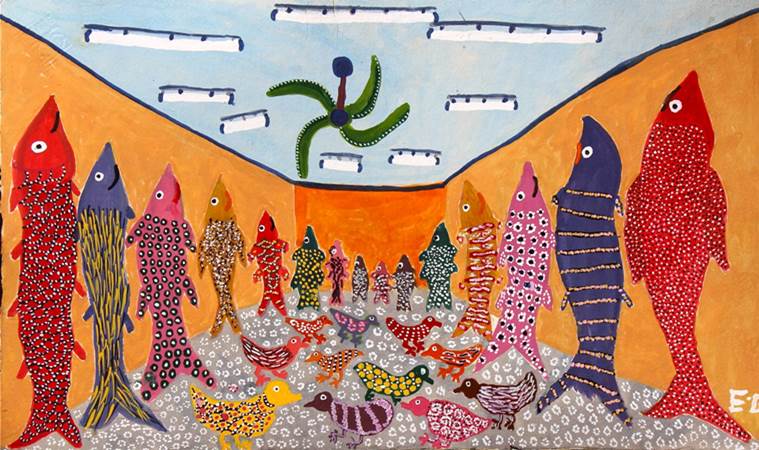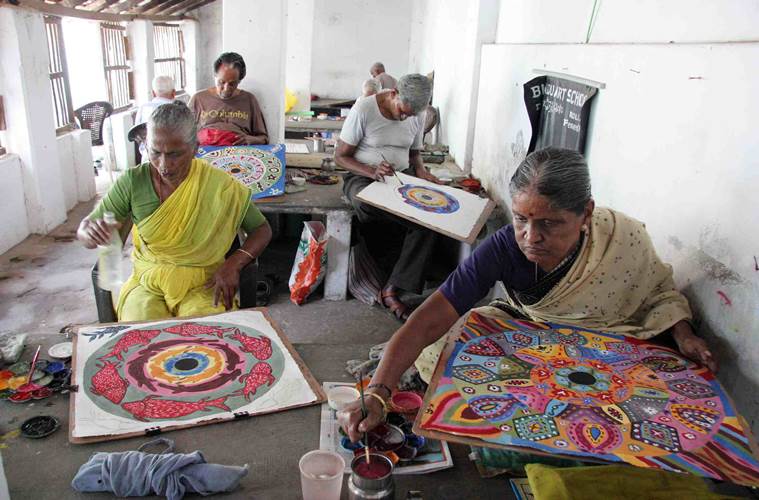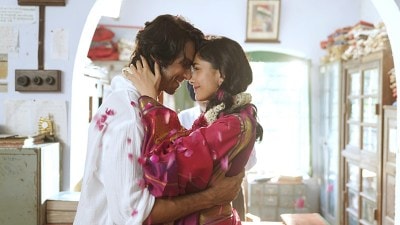- India
- International
Art for inclusion: An Austrian’s vision for Indian society
Dornik has been working with and for those afflicted with leprosy for years now, encouraging them to get over their pain — one brushstroke at a time.
 Dornik was on a ‘hippie trail’ to India in the year 1977, when he had his first encounter with leprosy.
Dornik was on a ‘hippie trail’ to India in the year 1977, when he had his first encounter with leprosy.
Inside one of the galleries in Delhi’s India International Centre, artist and curator Werner Dornik looks meditatively at a painting, as if to make sense of it. Hands placed carefully on his hips, he stares at the bizarre perspective of a room that is filled with multi-coloured fish rising towards the ceiling. “I have no idea why they would paint this; this imagination is all coming from inside them,” he says. The ‘they’ here refers to the students of Bindu Art School in Bharathpuram in Tamil Nadu, which Dornik himself helped set up to bring about a change in the lives of people affected by leprosy.
“‘Bindu’,” he tells indianexpress.com “comes from the idea that God created this universe from a little dot and everything else emerged and expanded from there. The students, too, have understood this, and it is reflective in their works,” he says, pointing to a series of paintings hung on the wall that shows a kaleidoscope of colours emanating from a black dot. It is the sixth day of the 11-day art exhibition in Delhi. And Dornik — a multimedia artist originally from Austria — has painfully curated the artworks over the years. Appositely named ‘From Pain to Paint’, it is officially the 15th year since Bindu Art School first exhibited its work. The journey itself has been strenuously long, albeit a rewarding one.
ALSO READ | Artist Sudipta Das’s doll-like sculptures share the trauma of the displaced
Inside the school, meanwhile, 45-year-old E. Deshamma — the creator of the unique, aforementioned fish painting, is busy working on another one of her creations. This one, too, involves fish. When indianexpress.com reaches out to her over the phone — a conversation aided by a translator — to understand the meaning of her paintings, she says, “I depict fish in my paintings because I am fond of them, especially the sea fish. In this particular painting, I wanted to show them hanging from the ceiling, just like how I see them inside some houses.”
Deshamma became an art-school regular way back in 2012, when a neighbour in the leprosy colony began attending it. “When I attend school, I forget all my pains and all the stigma. I don’t worry about anything else and immerse myself completely in paintings. This school taught me how to paint,” she says. Prior to this, Deshamma was a homemaker. She looked after her family, and the chickens in her house — something that she seems to have brought alive on the canvas.

 One of the students of the art school E. Deshamma painted this because she is extremely fond of fish.
One of the students of the art school E. Deshamma painted this because she is extremely fond of fish.
The year was 1977 when Dornik — who was on a ‘hippie trail’ to India — first encountered leprosy. “I was 18 and travelling alone. When I arrived at Varanasi, I met people who suffered from leprosy and needed treatment. Once I learned about their situation, I found it difficult to enjoy India,” he says, adding that he was about to give away all his money — which he had saved for his six-month trip — and return home when another idea struck him. “I returned the following year and went to Varanasi to click pictures of people and landscape. I exhibited my work back home, and used the money to help treat people”.
 The students of Bindu Art School begin their day with a 10-minute meditation session, following which they pick up their brushes and begin to paint.
The students of Bindu Art School begin their day with a 10-minute meditation session, following which they pick up their brushes and begin to paint.
By 2000, Dornik had had many exhibitions and multimedia shows. The funds he raised were used for the uplift of two leprosy colonies in Khandwa and Indore in Madhya Pradesh. With some money still left in his bank account — which Dornik did not touch for four years — the idea of starting an art school finally came to him. “I wrote to my friend Padma Venkataraman, a social activist who works in the leprosy colonies of Tamil Nadu, asking her to find out if the people were interested in painting. They would have to stop begging, though. This was 2005 — the year Bindu Art School was officially founded,” he says.
Dornik pauses and looks around the gallery. The colours that pop out of the paintings give the room a burst of energy — a paradoxical emotion and a far cry from when the artists first started to paint. “Society has not given them their due. They have been thrown out of their homes, disowned by families, and shunned. But, to overcome this pain, you have to work hard. These people overcame it somehow, and I started to see that they have so much of life experience. So, if they start to paint, there must be beauty in it,” he says.
The students of Bindu Art School are not professionals. And prior to this, they had never held paintbrushes. When they started, they could barely make a sketch. Dornik, along with some visiting artists from around the world taught them the basics. In the beginning, they would only use primary colours. But as each day passed, they became more experimentative. Today, their paintings comprise landscape, rural life, flora and fauna, and of course ‘bindu‘. Art, says Dornik, is not about having a technique. It is about expression. So, how and when did they begin to exude so much of skill?
 ‘Bindu’ — the idea that all forms of life emerge from a single dot. A painting by student V. Radha.
‘Bindu’ — the idea that all forms of life emerge from a single dot. A painting by student V. Radha.
“It all happened over the years. Normally, we begin with 10 minutes of meditation, wherein they all sit together and close their eyes. I have told them that the ideas will come to them. It works, somehow,” Dornik laughs. “I told them that they may be used to begging around for money, but it is time to stop all that and show the beauty, instead. Now they are able, they sponsor their families with the money they earn — the same families that once threw them out because of their condition,” he says.
ALSO READ | From wall art to bags: Pithora paintings get a new canvas
A portion of the funds they raise on these exhibitions is used for the development of the school. The bigger chunk is divided equally among the students. The paintings are priced Rs 3,000 and Rs 4,000, depending on whether or not they are framed. The exhibition is on till February 1, 2020.
More Lifestyle
Apr 25: Latest News
- 01
- 02
- 03
- 04
- 05




































